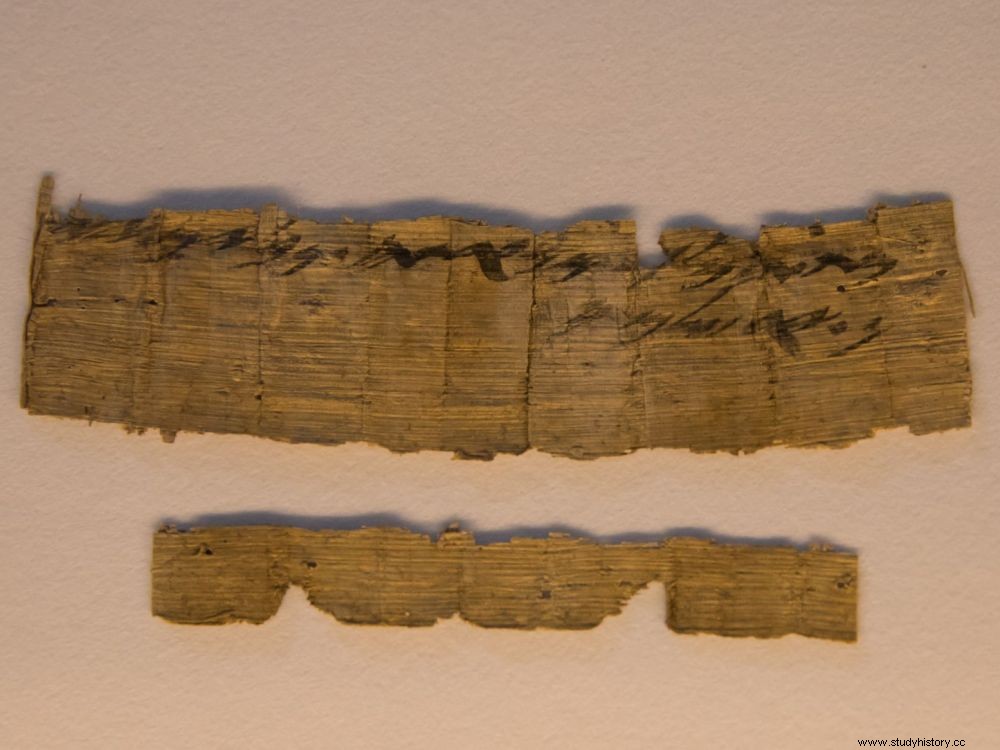The discovery of a papyrus fragment from the 7th century BC, would constitute the oldest Hebrew reference in Jerusalem.

This papyrus is dated to the 7th century BC. It bears the oldest Hebrew reference from Jerusalem.
It is a rare papyrus fragment of 11cm by 2.5cm, dated from the 7th century BC and which caused a sensation. Officially unveiled to the public at a press conference on Wednesday, October 26, 2016, the fragile manuscript is said to be the most archaic Hebrew reference known to date, clearly citing the name of Jerusalem. According to the Israel Antiquities Authority (AIA), the two lines of writing that cover the surface relate to a transfer of goods to warehouses established in Jerusalem, the capital of the kingdom of Judah. More specifically, "a delivery note for wine bottles". It would be the first non-religious original where the name of the famous city would appear. (Recall that the names of Rushalimu and Urusalim were already mentioned in the 20th and 14th century BC in Egyptian pharaonic papyri).
An announcement that falls after the severance of diplomatic ties between UNESCO and Israel
Seized by Israeli authorities before it was put up for sale on the black market, the document was reportedly found in the Hebron region of the Judean Desert. Radiocarbon dating as well as calligraphic studies (carried out by a specialist who wished to remain anonymous) place its origin in the 7th century BC, a period generally referred to as that of the First Temple. We can however be surprised at the timely revelation and the timing of the announcement, given the controversial atmosphere that currently reigns around Jerusalem, after the adoption by Unesco of a recent resolution (October 13 2016), tending to weaken the existing link between the City of three religions, and the Jewish people. A vote strongly condemned by the Director General of UNESCO.
"We had planned to make this announcement eight months ago, but the investigation was very long" , Amir Ganor, the head of the AIA's anti-smuggling unit, told AFP. The only two other Hebrew manuscripts from this period prior to the Babylonian conquest and the destruction of Jerusalem and its temple by the armies of Nebuchadnezzar in 587 BCE are the Marzeah Papyrus and a Dead Sea palimpsest. We also found inscriptions in the tunnel of Siloam and a few others on ceramic shards from the 7th century BC, ostracas exhumed in the fortress of Arad. "It is important to note that there is no trace of writing in the region before the end of the 8th century BCE" , had already told us Israel Finkelstein, the eminent archaeologist of the University of Tel Aviv*. All the other known manuscripts on papyrus and parchment are much later."You have to be very careful anyway" , said Christopher A. Rollston, specialist in ancient texts, professor at George Washington University (United States). He wished to warn:"The fact that the papyrus is actually dated to the 7th century BC does not mean that the writings therein are themselves of the same age..[…). Modern forgers may have used ancient papyrus with the intention of selling this rare fragment at a very high price, so I would say, "Not so fast", and would advise caution" , he hastened to conclude.
*Read the file of “Sciences et Avenir” n°743:“The Bible, the True and its Legend”.
